-
Key Takeaways
-
The Purpose of NOTAMs
- A Real-Life Example
- Same Acronym, Different Meaning
-
How to Read NOTAMs
- FAA Domestic Format
- !ORD 06/001 ORD RWY 04L/22R CLSD 2106231700-2106232300
- The exclamation point denotes the beginning of a new NOTAM.
- ICAO Format
-
NOTAM Types
-
NOTAMs and Preflight Planning
-
How to Find NOTAMs
- FAA Website
- Electronic Flight Bag (EFB)
- Other Online Services
- Flight Service Station (FSS) Dispatcher
- Flight Information Services – Broadcast (FIS-B)
-
NOTAM Challenges
- Tips For Utilizing NOTAMs
-
Conclusion
NOTAMs can be confusing and complicated to read. It’s tempting to scroll past them during preflight.
But you could find yourself in serious trouble if you don’t check NOTAMs before you take off.
Luckily, you don’t have to stay puzzled by NOTAMs.
This article breaks down each type of NOTAM, how to understand them, and where to find them.
Key Takeaways
- NOTAMs update pilots about changes in airspace, airports, and equipment that affect aircraft operations.
- Checking NOTAMs before flight is required by Federal Aviation Regulations (FAR 91.103).
- NOTAMs can be challenging to understand, but the information they provide prevents incidents and accidents.
The Purpose of NOTAMs
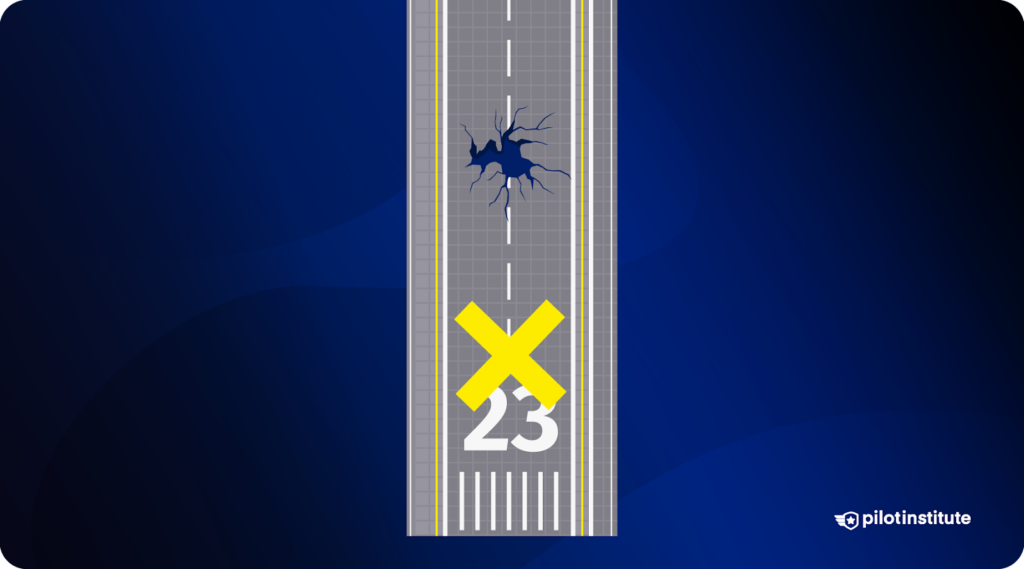
A Notice to Airmen (NOTAM) is a bulletin issued by a country’s aviation authority. The Federal Aviation Administration (FAA) issues NOTAMs in the United States.
NOTAMs alert pilots to issues that impact flight operations. Hazards, failures, and airspace or aerodrome changes are common reasons for NOTAM publication.
Here are some practical examples of NOTAMs:
- A NAVAID is out-of-service and could give false readings.
- A Temporary Flight Restriction (TFR) is active.
- An airport has closed a runway/taxiway/apron for maintenance.
- The warning light at the top of a radio tower near the airport has failed.
A Real-Life Example
Pilots who do not review NOTAMS before flight put themselves (and others) in danger. Here is an example of an accident caused by a lack of information documented by AOPA.
In 2007, an ATPL-rated pilot with 27,500 hours failed to check the NOTAMs at his destination airport. He landed on a closed turf runway, causing the aircraft to nose over. The aircraft was written off, and the occupants suffered minor injuries. The National Transportation Safety Board (NTSB) determined that the pilot’s failure to check the NOTAMs caused the crash.
Same Acronym, Different Meaning
Before we move on, you might have noticed that the FAA changed the meaning of the NOTAM acronym.
Originally, NOTAM used to stand for Notice to Airmen, but on December 2nd, 2021, NOTAM was changed to Notice to Air Mission. The term was considered “inclusive of all aviators and missions,” including drone operators.
However, as of February 10, 2025, the term “Notice to Air Missions (NOTAM)” was changed back to “Notice to Airmen (NOTAM)” and the title of FAA Order 7930.2 was changed to “Notice to Airmen (NOTAM)”.
How to Read NOTAMs
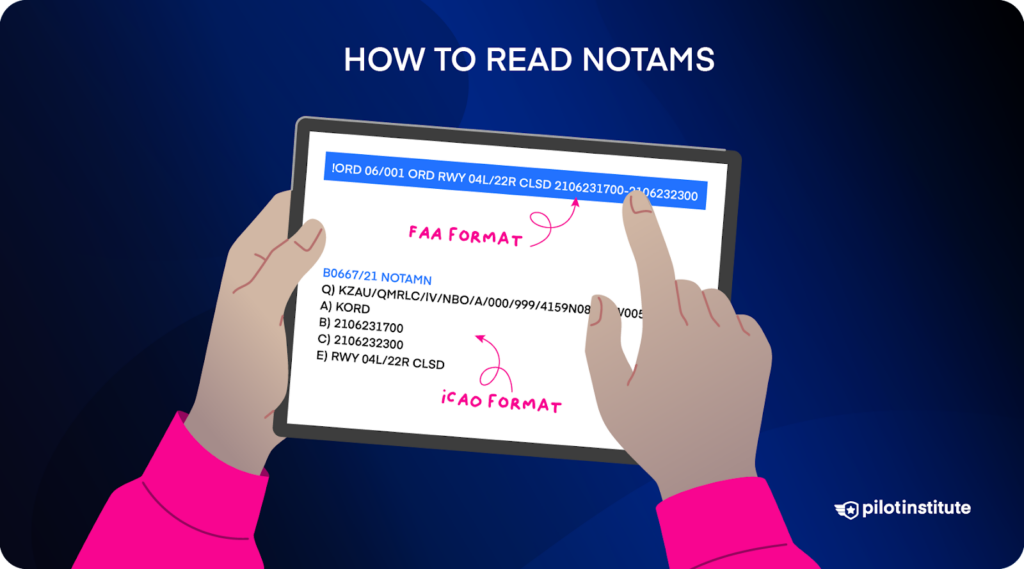
Before we cover the types of NOTAMs, let’s learn to decode them.
In the U.S., NOTAMs follow a proprietary, “domestic” format, although some are also published in the ICAO format. However, the FAA is modifying the domestic format to match ICAO’s. According to AOPA, the transition will occur in December 2024. At that point, the FAA will no longer use the domestic format.
The FAA published a useful document that compares the ICAO and domestic formats. In their example, runway 04L/22R is closed at Chicago O’Hare International Airport (ORD).
When distributed in the current FAA format, it looks like this:
!ORD 06/001 ORD RWY 04L/22R CLSD 2106231700-2106232300
When distributed in the ICAO format, the NOTAM will look like this:
B0667/21 NOTAMN
Q) KZAU/QMRLC/IV/NBO/A/000/999/4159N08754W005
A) KORD
B) 2106231700
C) 2106232300
E) RWY 04L/22R CLSD
Both formats have advantages and disadvantages. The FAA version is more concise, but the ICAO version is more organized.
The ICAO version’s multi-line structure is more readable with long NOTAMs. In contrast, the single-line FAA format makes complicated NOTAMs harder to read.
Let’s dive into how to decode each NOTAM format.
FAA Domestic Format
!ORD 06/001 ORD RWY 04L/22R CLSD 2106231700-2106232300
The exclamation point denotes the beginning of a new NOTAM.
- ORD is the accountability location. This represents the facility responsible for issuing the NOTAM (Chicago O’Hare Airport).
- 06/001 is the NOTAM Number. It represents the month issued (06) and the NOTAM number (001).
- ORD is the NOTAM location. This tells pilots where the NOTAM applies. In this case, it’s an airport, but it could be a NAVAID or Center ID.
- RWY 04L/22R tells us the subject is runway (RWY) 04L/22R. Each subject has its own FAA keyword.
- CLSD is the Condition: Closed.
- 2106231700-2106232300 is the time constraint. The start and end dates and times are coded in YYMMDDttt format (UTC time).
- This NOTAM starts at 1700Z on 6/23/2021 and ends on the same date at 2300Z.
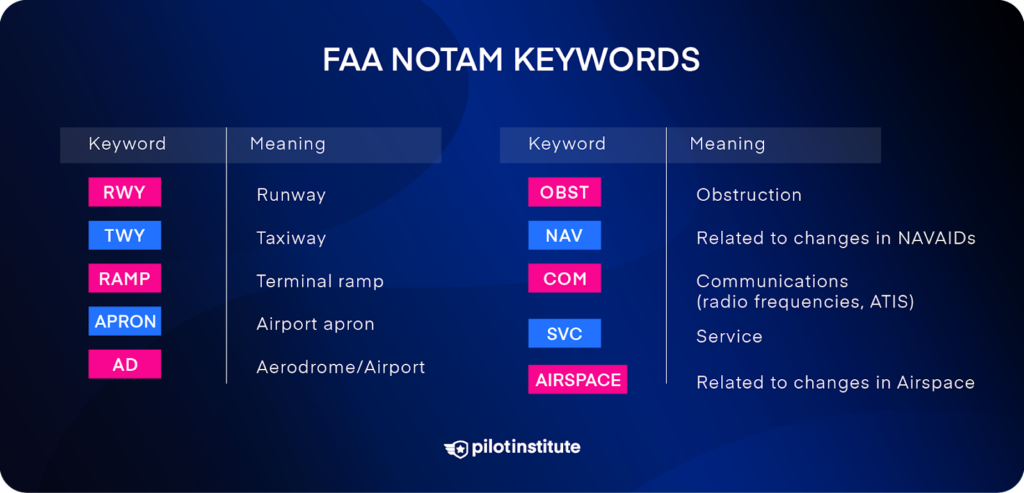
ICAO Format
B0667/21 NOTAMN
Q) KZAU/QMRLC/IV/NBO/A/000/999/4159N08754W005
A) KORD
B) 2106231700
C) 2106232300
E) RWY 04L/22R CLSD
The first item in the example NOTAM is B0667/21. It outlines the series (B), the number (0667), and the year (21).
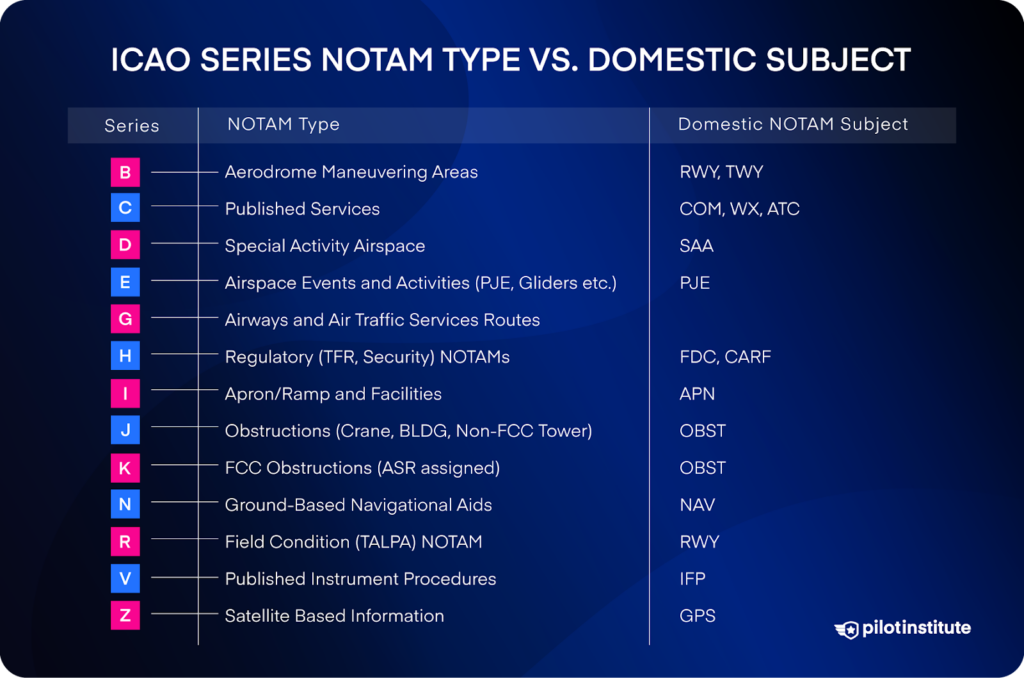
The second item, NOTAMN, indicates the type of NOTAM. There are three types of NOTAMs:
- New (N): a new NOTAM that presents information about a condition. Our example is a new NOTAM.
- Cancel (C): a previous NOTAM has been canceled (e.g., a closed runway has been reopened).
- Replace (R): updates the information from an older NOTAM.
The line starting with Q is the qualifier line:
Q) KZAU/QMRLC/IV/NBO/A/000/999/4159N08754W005
The qualifier line contains coded information.
- KZAU represents the flight information region (FIR) for the NOTAM. KZAU is the Chicago FIR.
- QMRLC is the NOTAM Code.
- The code always starts with Q.
- Subject: (MR) for landing and movement areas, runway.
- Condition: (LC) closed.
- IV represents the traffic type. IV means both IFR (I) and VFR (V).
- NBO is the NOTAM purpose. This NOTAM is intended for aircraft operators (N), for use in pre-flight briefing (B), and affects flight operations (O).
- A is the scope. A means it applies to an aerodrome.
- 000/999 represents the altitude limits: This NOTAM is for a ground-based issue, so altitude limits do not apply. The default values of 000 to 999 are used.
- 4159N08754W005 lists the coordinates (41°59’N 087°54’W) and the operational radius (5 NM).
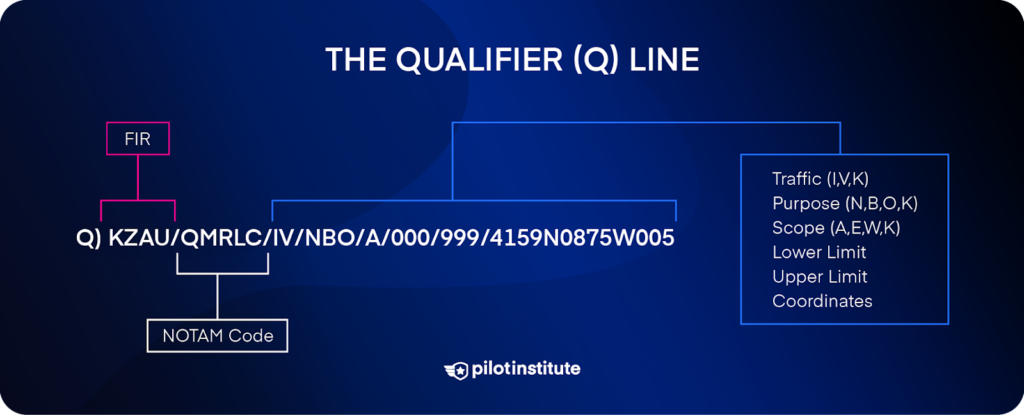
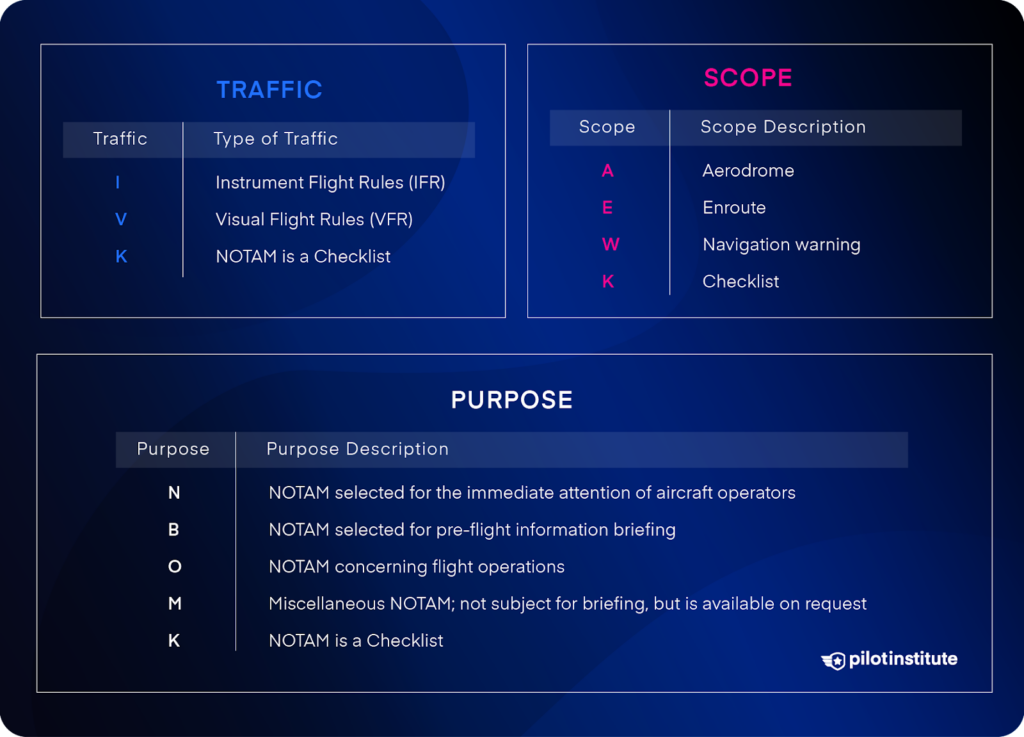
Check out the FAA’s (Q) Codes document for a complete list of ICAO NOTAM codes.
A) KORD represents the location of the aerodrome or the FIR in which the change in condition is reported.
B) 2106231700 is the start time and date in UTC.
C) 2106232300 is the end time and date in UTC.
D) The schedule is only used if the NOTAM is recurring. This NOTAM is not recurring, so it has no D line.
E) RWY 04L/22R CLSD is the NOTAM condition. This should look familiar after reading the domestic example.
F) The low altitude limit, which is only used with airspace NOTAMs.
G) The upper altitude limit, which is only used with airspace NOTAMs.
NOTAM Types

Now that we know how to read domestic and ICAO NOTAMs, let’s learn what they can tell us.
NOTAMs come in many different types, each with its own purpose. In this section, we’ll cover ten of the most common NOTAMs pilots encounter.
NOTAM (D)
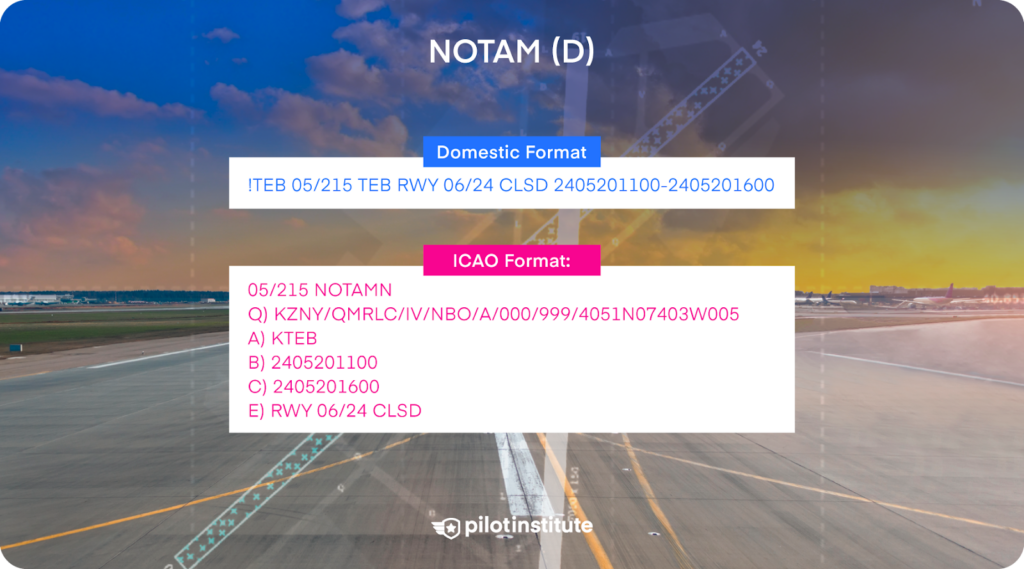
In the U.S., the D means distant. The FAA currently publishes these NOTAMs in the domestic and ICAO formats.
These NOTAMs outline operation-sensitive information about the following:
- Public-use airports, seaports, and heliports.
- En Route NAVAIDs.
- Services.
- Procedures.
- Hazards.
- Aeronautical facilities.
There are also two subtypes of NOTAM (D):
- (U) NOTAM: This is an unverified report. It requires the authorization of an airport manager before publishing.
- (O) NOTAM: O means other. These NOTAMs don’t meet standard NOTAM criteria. However, they can be valuable for pilots to know.
Here is an example of a NOTAM (D) for a permanently closed taxiway at JFK airport:
!JFK 09/317 JFK TWY WA BTN TWY A AND TWY B CLSD 2309191827-PERM
FDC NOTAM
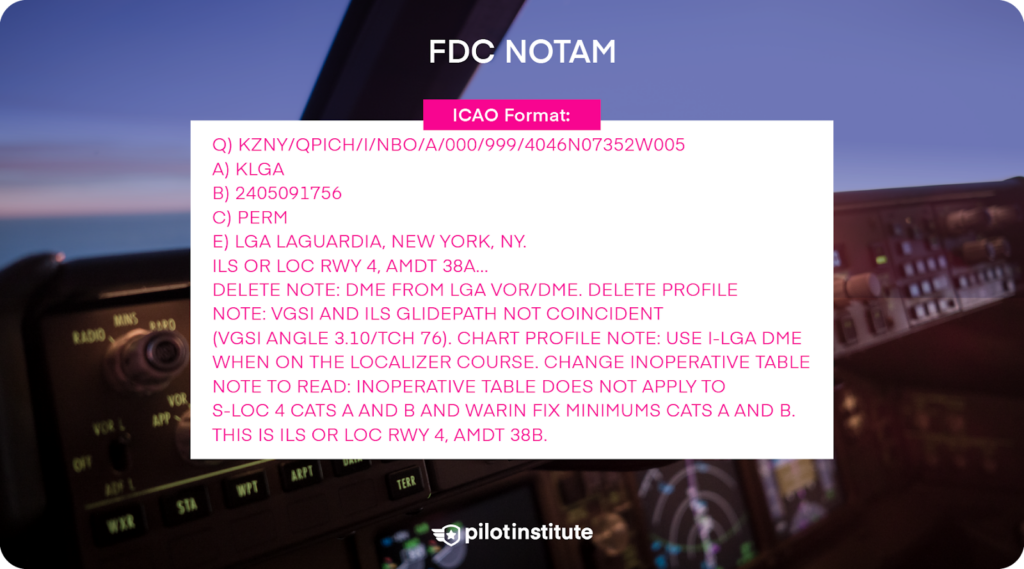
Flight Data Center (FDC) NOTAMs outline changes affecting instrument flight rules (IFR) operations. These include changes made to instrument approaches, STARs, SIDs, and IFR airways. FDC NOTAMs also provide information about TFRs and other special airspace.
FDC NOTAMs also include warnings for high barometric pressure areas. High-pressure conditions decrease altimeter accuracy, affecting terrain clearance and aircraft spacing.
Here is an example of an FDC NOTAM (domestic format) asking pilots to verify the aircraft’s departure procedure is correct:
!FDC 3/2226 JFK SID JOHN F KENNEDY INTL, NEW YORK, NY.
KENNEDY FIVE DEPARTURE…
NOTE: RWY 31L, BREEZY POINT CLIMB: FOR RNAV (GPS) USAGE, CONFIRM RNGRR IS CORRECTLY LOADED INTO FMS PRIOR TO DEPARTING RWY 31L.
Pointer NOTAM
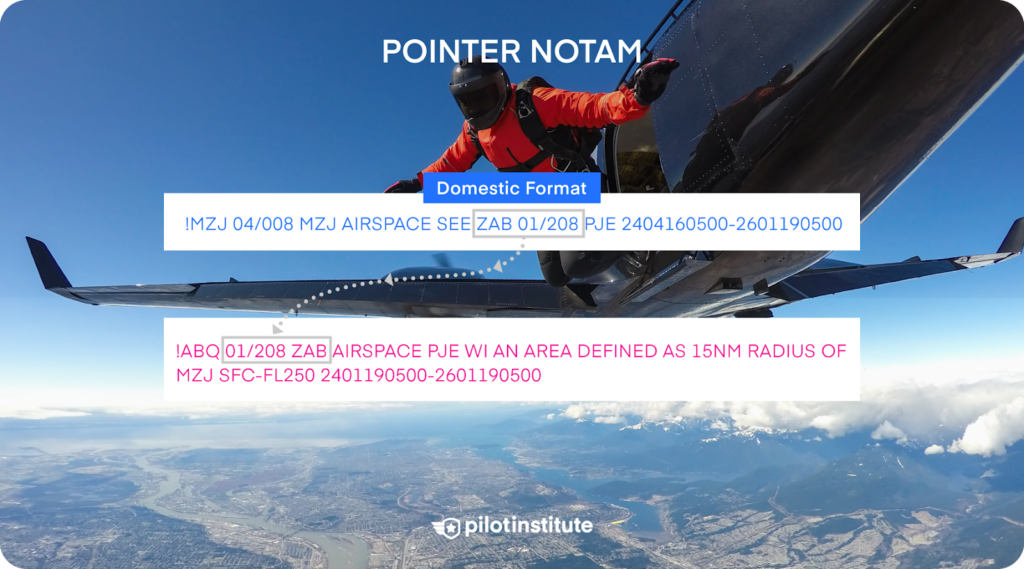
A pointer NOTAM “points” pilots to another NOTAM.
Here is an example of a Pointer NOTAM:
!CPR CPR AIRSPACE SEE DDY 12/045 PJE WEF 0812141400-0812141830
This NOTAM “points” from the CPR airport to a nearby parachute jumping exercise (PJE) NOTAM. It’s not directly related to the CPR airport, but pilots flying out of CPR should know about it.
A secondary benefit is that the pointer can be short, reducing the amount of text pilots must read. If the pilot determines the NOTAM affects them, they can seek the full text in the DDY 12/045 NOTAM.
SAA NOTAM
Special Activity Airspace (SAA) NOTAMs cover changes to special airspace operating hours. SAA NOTAMs include Special Use Airspace (SUA), military training routes (MTRs), and others.
Here is an example of a SAA NOTAM:
!SUAC 04/415 ZHU AIRSPACE R3803A ACT SFC UP TO BUT NOT INCLUDING FL180 2404180501-2405020500
This NOTAM informs pilots when the Restricted Area R3803A will be active.
FICON NOTAM
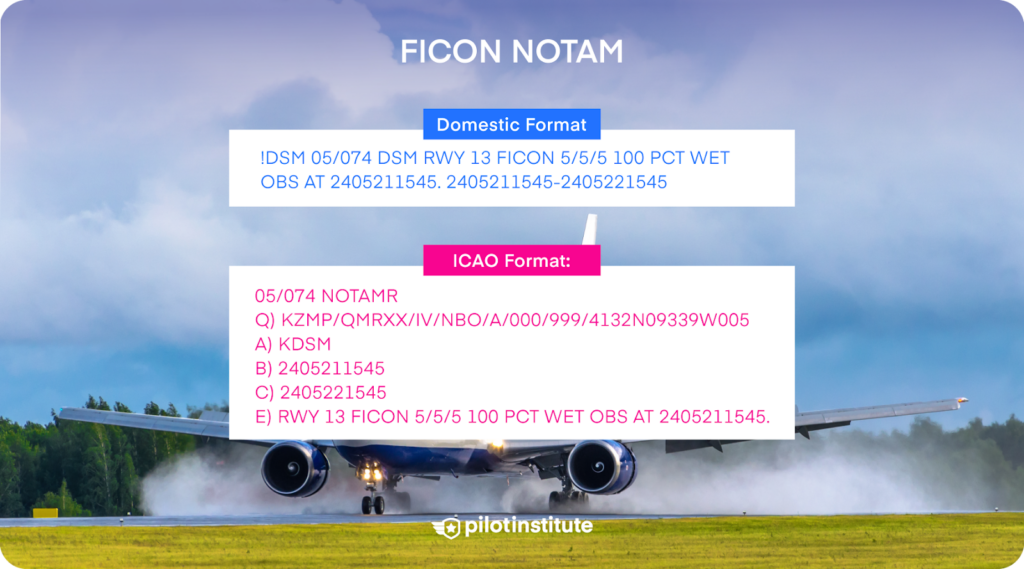
A Field Condition (FICON) NOTAM informs pilots about runway conditions at an airport.
Here is an example of a FICON NOTAM:
RWY 26 FICON 4/3/3 50 PRCT COMPACTED SN, 75 PRCT 1IN WET SN OVER COMPACTED SN, 90 PRCT 2IN WET SN OVER COMPACTED SN
In this example, runway 26 has reduced braking action due to wet, compacted snow.
GPS NOTAM
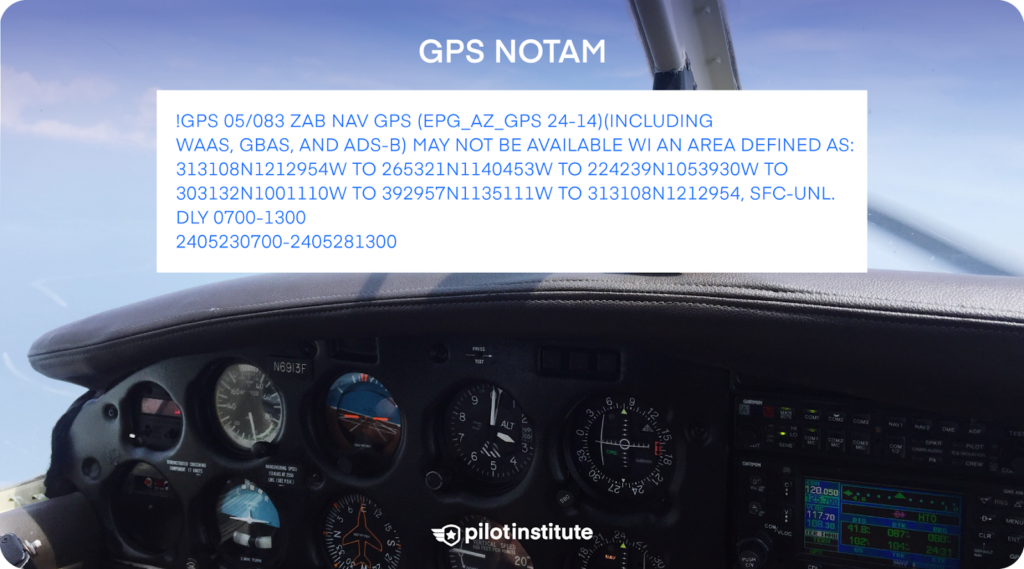
GPS NOTAMs notify pilots about changes to GPS availability, such as outages and decreased accuracy in specific areas. If you plan on flying in these areas, make sure you aren’t relying on GPS as your navigation source.
Here is an example of a GPS NOTAM:
!GPS 04/055 ZLA NAV GPS (YPG_AZ GPS 24-01) (INCLUDING WAAS, GBAS,
AND ADS-B) MAY NOT BE AVBL WI A 304NM RADIUS CENTERED AT
325500N1135500W (BZA061036) FL400-UNL,
237NM RADIUS AT FL250,
182NM RADIUS AT 10000FT,
167NM RADIUS AT 4000FT AGL,
149NM RADIUS AT 50FT AGL
DLY 1830-2230
2404221830-2404262230
This NOTAM alerts pilots that WAAS, GBAS, and ADS-B might not be available within a 304 NM radius from a specific location. The location is listed in coordinate (325500N1135500W) and NAVAID bearing/distance (BZA061036) format.
Military NOTAM
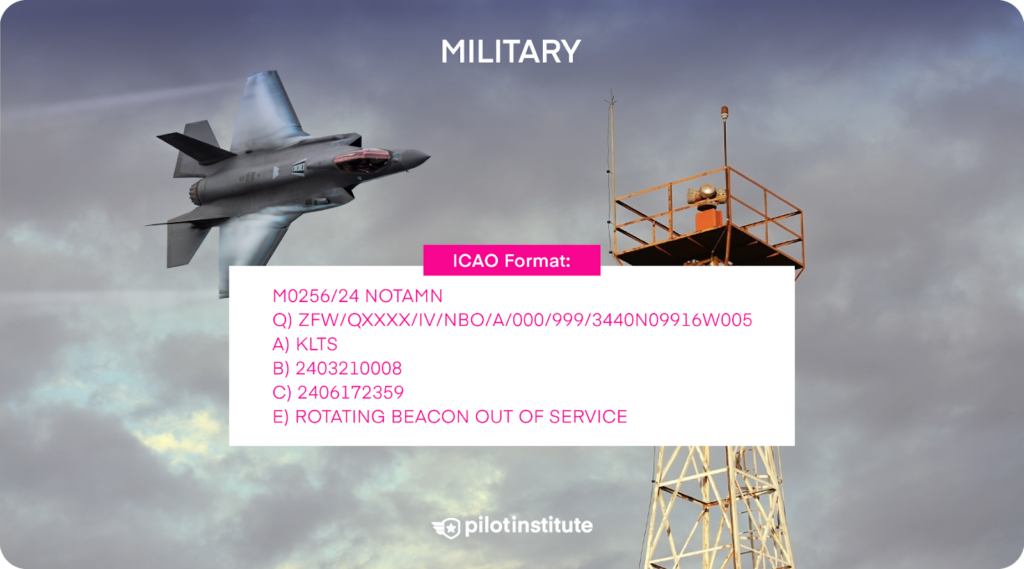
These NOTAMs pertain to U.S. military pilots, military-specific airspaces, and NAVAIDS such as VORTACs.
Here is an example of a military NOTAM in ICAO format:
M0256/24 NOTAMN
Q) ZFW/QXXXX/IV/NBO/A/000/999/3440N09916W005
A) KLTS
B) 2403210008
C) 2406172359
E) ROTATING BEACON OUT OF SERVICE
This NOTAM alerts military pilots that the rotating beacon is out of service at Altus Air Force Base (LTS).
International NOTAM
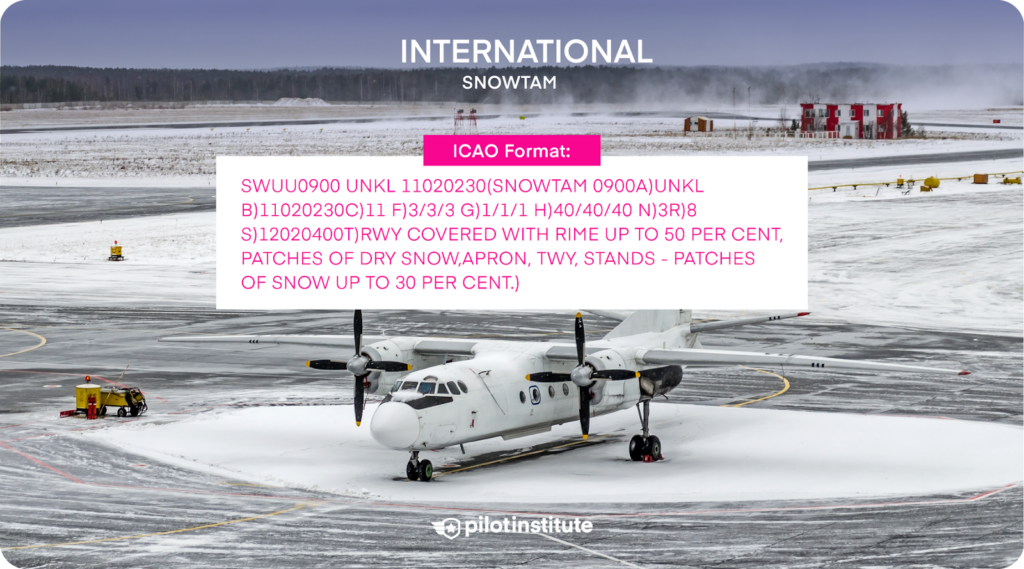
These are NOTAMs that are circulated in more than one country. The FAA has access to certain international NOTAMs, but not all of them. Pilots should know that these NOTAMs are not included in regular flight briefings and must be explicitly requested.
An example of an International NOTAM is the SNOWTAM. It provides the pilot with a surface condition report for each runway at an airport.
Here is an example of a SNOWTAM:
SWEN0393 ENHF 04200155
(SNOWTAM 0393 A) ENHF B) 04200243 C) 05 F) 48/7/47 G) 02/XX/03 H) 60/58/53 GRT N) 47 R) 47 T) RWY SANDED)
This SNOWTAM tells us the type and depth of contamination, braking action, and more for runway 5 at ENHF. For a full decoding, check out this website.
Class I NOTAM
A Class I NOTAM is an ICAO NOTAM distributed by telecommunication, such as radio, rather than written materials.
Class II NOTAM
A Class II NOTAM is distributed via means other than telecommunication, such as written or online publications. It is presented in the ICAO format and published every 28 days.
NOTAMs and Preflight Planning
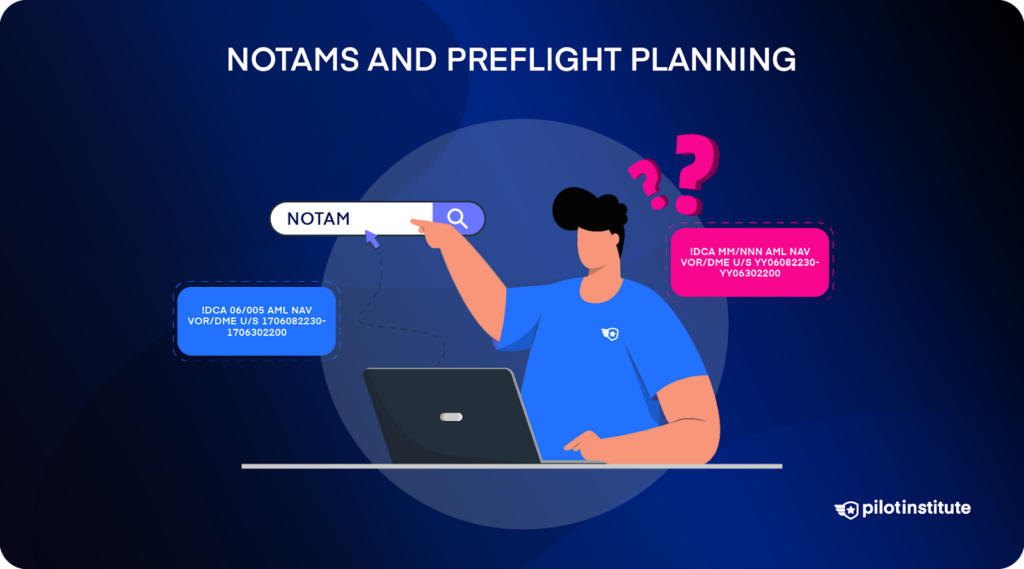
We know that not checking NOTAMs before flight can cause accidents. But did you know that it also goes against Federal Aviation Regulations?
FAR 91.103 states, “A pilot in command shall, before beginning a flight, become familiar with all available information concerning that flight.”
NOTAMs certainly fall under the definition of “all available information.” So, you should check the NOTAMs for the entire length of your route. Should you violate a published TFR, the FAA will not hesitate to use FAR 91.103 against you.
How to Find NOTAMs
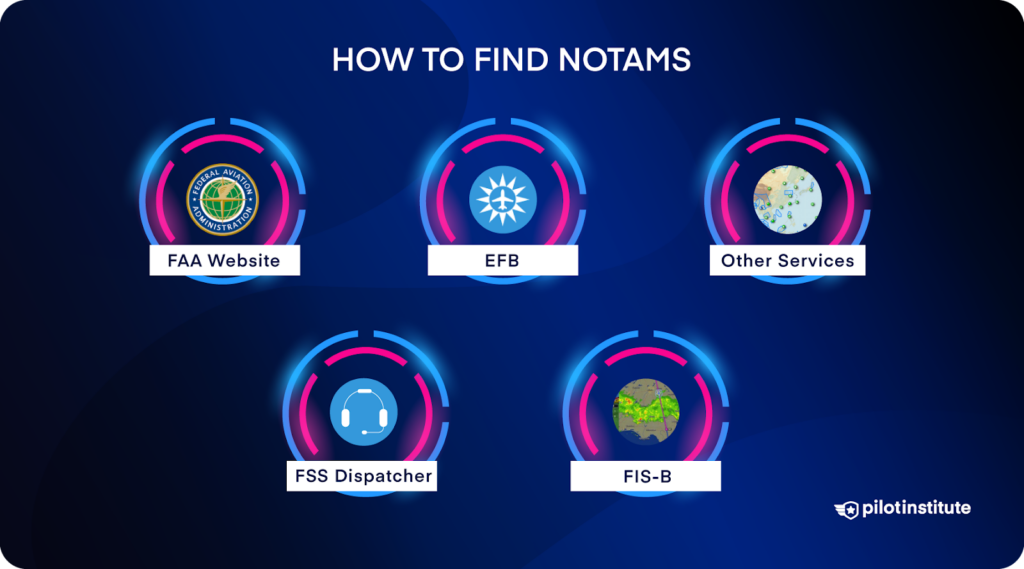
NOTAMs are vital to flight safety, but where to find them is not obvious. Here are some resources for getting the latest NOTAMs.
FAA Website
The FAA has a dedicated website with all the NOTAMs available for the country. You can search for the NOTAMs you want in many ways, such as by identifier, keyword, coordinates, etc.
Electronic Flight Bag (EFB)
EFBs have made flight planning easier and more convenient than ever. Gone are the days when a pilot had to meticulously search for the appropriate NOTAMs.
When you plan a flight using an EFB such as ForeFlight, the software will pull up any NOTAMs along your route. All you have to do is look.

Other Online Services
There are other online services that you can use to search for NOTAMs. Notable examples include 1800WXBRIEF by Lockheed Martin Flight Services and SkyVector Flight Planning.
When you submit your flight plan on the website, you can view the relevant NOTAMs.
Flight Service Station (FSS) Dispatcher
Finally, you can call your FSS dispatcher for a weather briefing and relevant NOTAMs. The FSS dispatcher will provide you with important NOTAM (D)s. However, unless you specifically ask, they won’t give you the complete list of NOTAMs.
Flight Information Services – Broadcast (FIS-B)
Many NOTAMs, such as NOTAM (D)s, TFRs, and airspace NOTAMs, are broadcast over FIS-B.
An ADS-B In device allows you to receive FIS-B in the cockpit from almost anywhere in the country. Many pilots find the data provided by ADS-B In much easier to use than calling up an FSS.
NOTAM Challenges
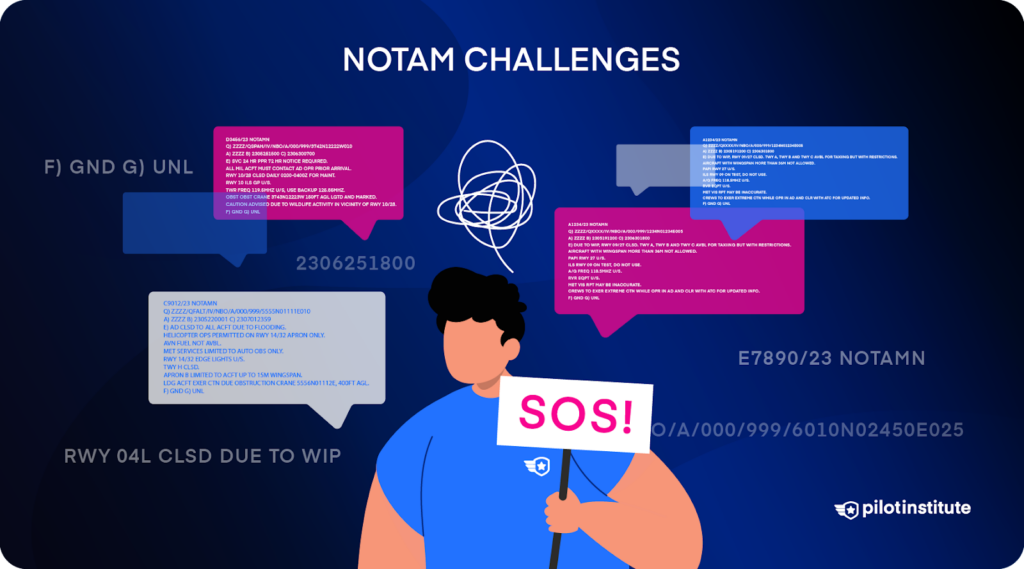
Pilots have a love-hate relationship with NOTAMs. On the one hand, they are essential sources of information. On the other hand, they are hard to read and often contain too much information.
In addition, where you source NOTAMs from can change their usefulness. A pilot might miss an important NAVAID NOTAM because it’s not in the same airspace.
How can we avoid these NOTAM pitfalls?
Tips For Utilizing NOTAMs
The easiest way to use NOTAMs successfully is to let technology work for you. Use an EFB or a flight planning service to provide you with the NOTAMs along your route.
Once you have all the NOTAMs for the route, it’s time to do the work and check if they affect your flight. Is there a NOTAM for the approach you intend to use? Does an airspace NOTAM affect your chosen cruising altitude? Is the NOTAM active while you’re flying? What if your ETA changes? How about NOTAMs at alternate airports?
These are all questions you should be asking when organizing your NOTAMs.
Also, consider purchasing an ADS-B In receiver. Having the latest NOTAMs at your fingertips during flight is an amazing resource.
Conclusion
NOTAMs are an essential resource for pilots. In fact, they’re so essential that when the U.S. NOTAM system failed in 2023, the FAA grounded all domestic flights.
Reviewing NOTAMs is not only a legal obligation. It can make the difference between a safe flight and tragedy. Make sure you have the latest information concerning your flight, even if it’s only a short hop.
If you’re preparing for a practical test, know NOTAMs inside and out. Practice decoding them by hand. Your Designation Pilot Examiner (DPE) will check if you know the NOTAMs during your test. Do you want to know more about how NOTAMs affect cross-country planning? Check out our article on the best ways to plan your cross-country flight.



